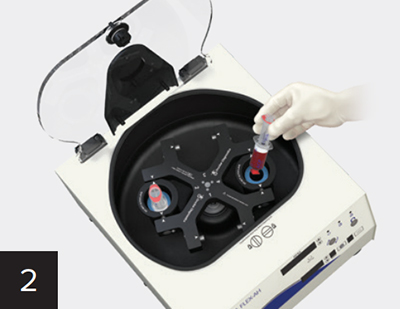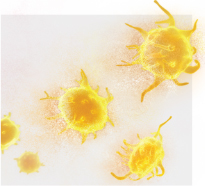PRP with the Arthrex ACP® Double-Syringe System
Introduction
Healing after an injury involves a well-orchestrated and complex series of events where proteins in the blood act as messengers to regulate the healing process. Many proteins involved in the healing process are recovered from small cell fragments found in blood called platelets. When you are injured, the platelets activate and start to gather at the injury site to release beneficial proteins called growth factors. This is the beginning of the healing cascade.
What Is Platelet-Rich Plasma (PRP)?
PRP is a concentration of platelets and growth factors created from blood. To create PRP, blood is centrifuged to separate the platelets from other unwanted cellular components. PRP contains increased levels of platelets and growth factors, which have the potential to improve cells’ ability to respond to an injury.

Whole blood is collected in a syringe and placed into the ACP system.

The syringe is placed in a centrifuge, which spins the blood.

After centrifugation the blood is separated into different layers. Using the ACP device, the concentrated platelets are collected into the inner syringe.
Making Your Cells Count With the Arthrex ACP® Double-Syringe System
Growth factors are always present in blood and inside platelets. Platelets are inactive in our bloodstream, but become activated when an injury occurs. They collect at the injured site and release these proteins (the growth factors), which in turn promote the healing process.1
PRP created with the ACP system harnesses this principle. The ACP system concentrates platelets while reducing the amount of unwanted blood components that could cause inflammation, to support the body’s self-healing processes.2-4


How Does the PRP Process Work?
Your health care provider will collect your blood using a typical blood-draw procedure. They place the blood into the ACP system, which uses a rapid spinning process to separate and concentrate the platelets and other beneficial growth factors from the blood. This process is typically done in 5 minutes.
Am I a Candidate?
Your health care provider will perform an examination to determine if PRP treatment is right for you or if another treatment regimen is better suited for your procedure. Your doctor will determine your pre- and post procedural protocol. Blood is usually collected from a vein in the upper arm.

Indications
The Arthrex ACP® double-syringe kit is indicated for the safe and rapid preparation of autologous PRP from a small sample of peripheral blood at the patient’s point of care. The PRP is mixed with autograft and/or allograft bone prior to application to a bony defect for improving handling characteristics.
Contraindications
- Blood supply limitations and previous infections, which may hinder healing
- Any active infection or blood supply limitations
Adverse Effects
Infections, both deep and superficial; allergies and other reactions to device materials; hematoma; damage to blood vessels and nerve damage resulting in pain or numbness from autologous sampling; delayed wound healing.
Reference
- Eisinger F, Patzelt J, Langer HF. The platelet response to tissue injury. Front Med (Lausanne). 2018;5:317. doi:10.3389/fmed.2018.00317
- Borregaard N, Sørensen OE, Theilgaard-Mönch K. Neutrophil granules: a library of innate immunity proteins. Trends Immunol. 2007;28(8):340-345. doi:10.1016/j.it.2007.06.002
- Arthrex, Inc. LA0810. Naples, FL; 2019.
- Arthrex, Inc. Data on file (APT-4153). Naples, FL; 2019.








